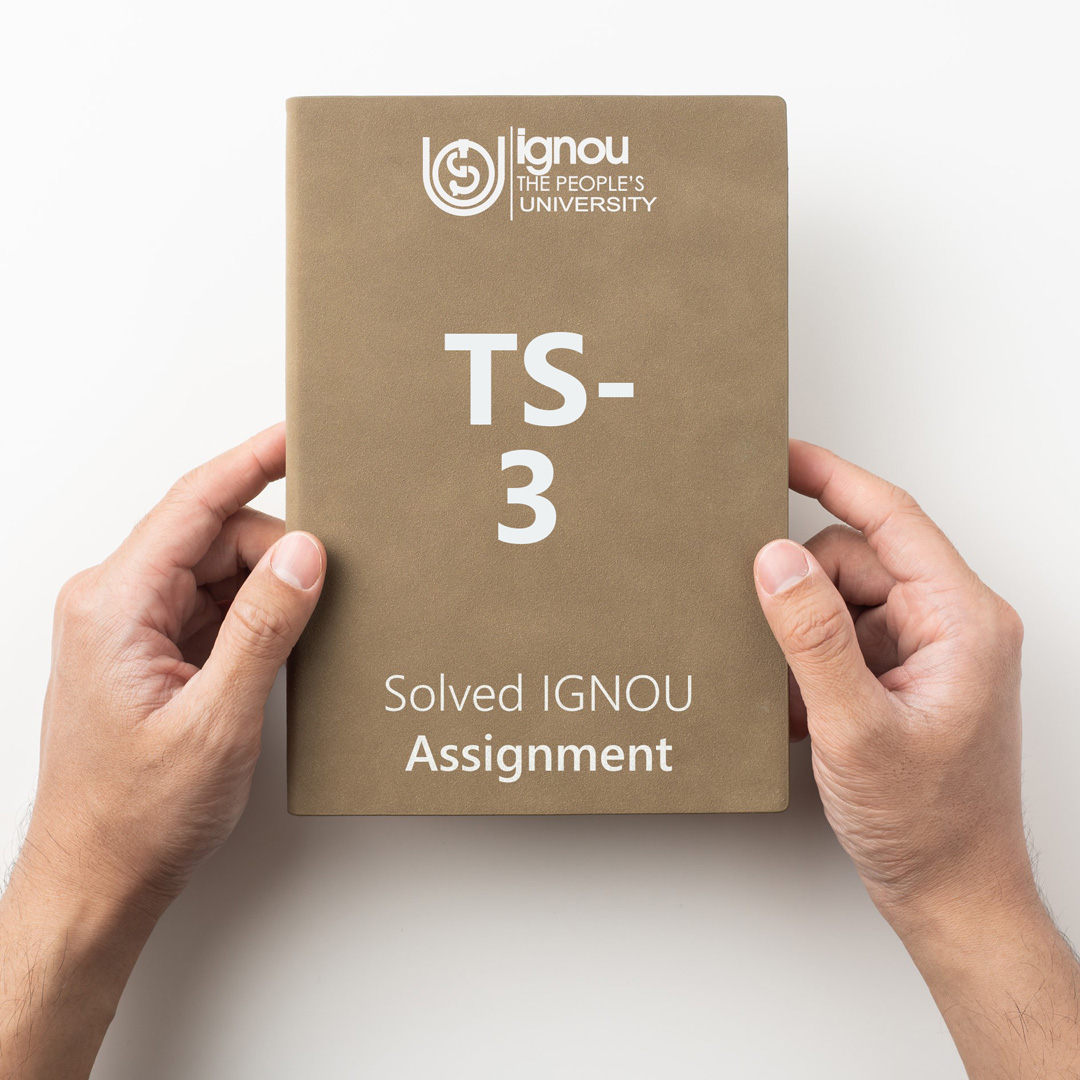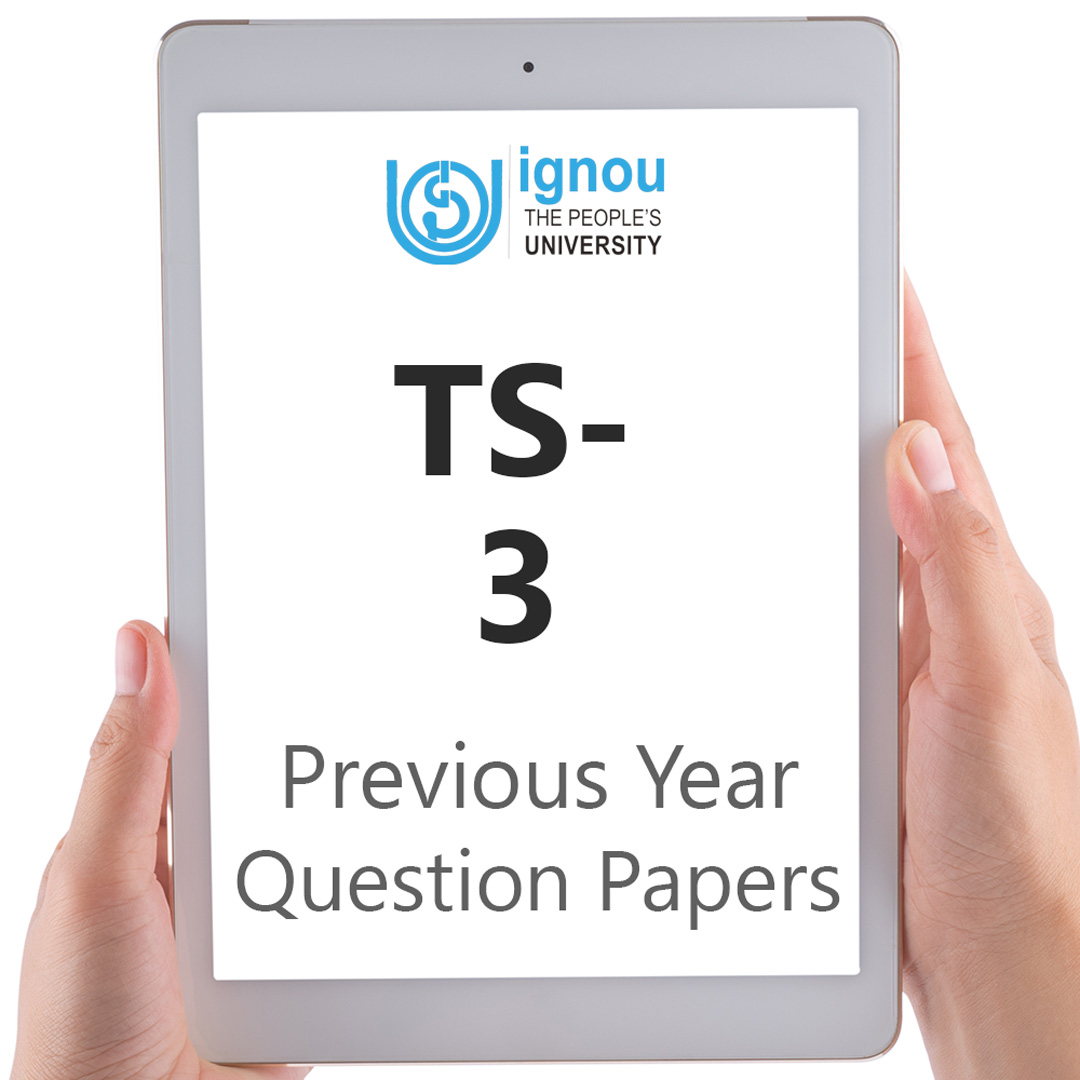If you are looking for TS-3 IGNOU Solved Assignment solution for the subject Management in Tourism, you have come to the right place. TS-3 solution on this page applies to 2023 session students studying in BTS, MTTM, DTS, BHM courses of IGNOU.
TS-3 Solved Assignment Solution by Gyaniversity
Assignment Code: TS-3/TMA/2022
Course Code: TS-3
Assignment Name: Management in Tourism
Year: 2022
Verification Status: Verified by Professor
1. What do you understand by Entrepreneurship? What are the qualities to become a successful entrepreneur in tourism sector? 20
Ans) Entrepreneurship is the ability and readiness to develop, organize and run a business enterprise, along with any of its uncertainties in order to make a profit. The most prominent example of entrepreneurship is the starting of new businesses. In economics, entrepreneurship connected with land, labour, natural resources and capital can generate a profit. The entrepreneurial vision is defined by discovery and risk-taking and is an indispensable part of a nation’s capacity to succeed in an ever-changing and more competitive global marketplace.
Qualities of Successful Entrepreneur
Self-Discipline: The first trait that all successful entrepreneurs must possess is self-discipline. Self-discipline is the single most important quality for success in life and business. If we can discipline ourself to do what you should do, whether we feel like it or not, your success is virtually guaranteed. Self-discipline requires self-mastery, self-control, self-responsibility, and self-direction. The difference between successful entrepreneurs and failures is that successful entrepreneurs make a habit of doing the things that failures don't like to do.
Integrity: The second trait that all successful entrepreneurs must possess is integrity. Perhaps the most valued and respected quality we can develop is a reputation for absolute integrity. Be perfectly honest in everything we do and in every transaction and activity. Never compromise our integrity. Remember that our word is your bond, and your honour is everything when it comes to your business. All successful business is based on trust. Our success in becoming an entrepreneur will be determined solely by the number of people who trust us, are willing to work for us, give you credit, lend us money, buy our products and services, and help us during difficult times. Our character is the most important asset that we develop in your entire life, and our character is based on the amount of integrity our practice.
Persistence: The third trait that all successful entrepreneurs must possess is persistence. Persistence is the iron quality of character. Persistence is to the character of man as carbon is to steel. It is an indispensable quality that goes hand in hand with all great success in life. Here is one of the great secrets to persistence and success: Program our subconscious mind for persistence well in advance of the setbacks and disappointments that we are going to have on our upward quest toward success. Resolve in advance that we will never give up, no matter what happens. The courage to persist in the face of adversity and disappointment is the one quality that, more than anything, will guarantee your success.
A Clear Sense of Direction: The fourth trait that all successful entrepreneurs must possess is a clear sense of direction. Because of the turbulence and rapid change in today's marketplace, most business owners have been reduced to operating day-by-day, almost like firefighters. They are totally preoccupied with short-term problems and the need to get short-term sales and profits. They intend to spend more time thinking and planning for the future, but they don't ever seem to get around to it. This is not for successful business owners.
Decisive and Action Oriented: The final trait that all successful entrepreneurs must possess is being decisive and action oriented. They must think and make decisions quickly. They discipline themselves to take action and to carry out the decisions they have made. They move fast and they get quick feedback from their actions. If they find they have made a mistake, they quickly self-correct and try something else. The key to triumph is for you to try.
2. Define an organization. Briefly discuss four types of organizational structures. 20
Ans) Louis Allen, “Organization is the process of identifying and grouping work to be performed, defining and delegating responsibility and authority and establishing relationships for the purpose of enabling people to work most effectively together in accomplishing objectives.” In the words of Allen, organization is an instrument for achieving organizational goals. The work of each and every person is defined, and authority and responsibility is fixed for accomplishing the same.
Koontz and O’Donnell, ‘The establishment of authority relationships with provision for co-ordination between them, both vertically and horizontally in the enterprise structure.” These authors view organization as a coordinating point among various persons in the business.
Types of Organizational Structures
There are four types of organizational structures. Understanding how they work and what their benefits and drawbacks are can help us make a more informed decision as to which to implement in our workplace. The four types are:
Functional structure: In a functional structure, organizations are divided into specialized groups with specific roles and duties. A functional structure is also known as a bureaucratic organizational structure and is commonly found in small to medium-sized businesses. Most people in the workforce have experience working in this type of organizational structure. For example, many companies divide their organization into various departments such as finance, marketing and human resources. Each of these departments then has a manager who oversees it. This manager is then supervised by an administrator or executive who oversees multiple departments.
Divisional structure: In a divisional structure, various teams work alongside each other toward a single, common goal. Each of these divisions has an executive who manages how that branch operates, controls its budgets and allocates its resources. Large companies employ this type of organizational structure. One example of the divisional structure is a car company that separates its company into SUV, electric or sedan vehicle branches. While each branch has its own function, they all work toward the same goal of making a sale. This is also known as the multi-divisional structure.
Flatarchy: In a flatarchy, there are little to no levels of management. A company using this structure could have only one manager in between its executive and all other employees. It is called a flatarchy because it is a hybrid of a hierarchy and a flat organization. This type of organizational structure is used more by smaller companies since they have fewer employees, though it can be used in companies of all sizes. While some companies grow out of this organizational structure, others continue to use it.
Matrix structure: In the matrix style of organizational structure, employees are divided into teams that report to two managers—a project or product manager along with a functional manager. In essence, a matrix structure is a combination of various organizational structures. Because these teams have two managers, a matrix structure promotes duality and the sharing of resources. Employees working for companies using the matrix structure have the potential to widen their skill set since they might be assigned to various projects requiring different levels of expertise or skills.
3. Discuss in detail about Human Resource planning. What role appraisal system plays in motivating employees?
Ans) Human Resource Planning is the process of forecasting the future human resource requirements of the organization and determining as to how the existing human resource capacity of the organization can be utilized to fulfil these requirements. It, thus, focuses on the basic economic concept of demand and supply in context to the human resource capacity of the organization. It is the HRP process which helps the management of the organization in meeting the future demand of human resource in the organization with the supply of the appropriate people in appropriate numbers at the appropriate time and place. Further, it is only after proper analysis of the HR requirements can the process of recruitment and selection be initiated by the management. Also, HRP is essential in successfully achieving the strategies and objectives of organization.
In fact, with the element of strategies and long term objectives of the organization being widely associated with human resource planning these days, HR Planning has now become Strategic HR Planning. Though, HR Planning may sound quite simple a process of managing the numbers in terms of human resource requirement of the organization, yet the actual activity may involve the HR manager to face many roadblocks owing to the effect of the current workforce in the organization, pressure to meet the business objectives and prevailing workforce market condition.
HR Planning, thus, help the organization in many ways as follows:
HR managers are in a stage of anticipating the workforce requirements rather than getting surprised by the change of events
Prevent the business from falling into the trap of shifting workforce market, a common concern among all industries and sectors
Work proactively as the expansion in the workforce market is not always in conjunction with the workforce requirement of the organization in terms of professional experience, talent needs, skills, etc.
Organizations in growth phase may face the challenge of meeting the need for critical set of skills, competencies and talent to meet their strategic objectives so they can stand well-prepared to meet the HR needs
Considering the organizational goals, HR Planning allows the identification, selection and development of required talent or competency within the organization.
Role of Appraisal System in Motivating Employee
One of the secrets of a good performing company is the fact that they recognized the importance of staff motivation. Watch out for companies that are 10 years old and above, the secret of their sustenance and longevity lies on the above truth. A solid and good management doesn’t joke with the above notion.
The truth of the matter is this; for a staff to work efficiently and effectively, employees must be motivated. This means that their efforts should be rewarded with physical, financial and psychological benefits and incentives so that they could maintain a high level of morale, satisfaction, and productivity. It means that workers should be stimulated to take a desired course of action by providing them with the opportunities to gain what they want.
Employee motivation is a function of all managers in general and of personnel managers in particular. The main objectives of staff performance appraisal are as follows:
To identify and reward competence and excellence
To identify staff training needs and develop the potential of those employs who can satisfy different future manpower needs within the organizations.
To identify performance deficiencies and spur improvements in them
To motivate employees to be highly productive based on their knowledge of a forthcoming evaluation of their performance
4. List the steps for setting up a Tour Operator Company. Why do you think it is important to provide quality service in tourism? 20
Ans) Following are steps for setting up a Tour Operator Company:
Name the tour business: Our tour name will be used in all of our documentation. Make sure our name is both memorable and descriptive.
Design a tour logo: Our logo is the visual representation of our business. It will be used in all of your marketing collateral. Pick a simple design that plays into our niche and story.
Register your business: There are different options for how we register— sole proprietorship, partnerships, corporations. Evaluate the pros and cons of each before we make our decision.
Get your business license and permits: Once we’ve registered our business, we’ll need to get a local business license. Then. check in with our local municipality to do this.
Register as a tour guide: If we are guiding, we might need to complete a course to become a licensed tourist guide. This allows us to take tourists around a designated geographical area.
Open a business bank account: This will help us keep track of all our expenses and revenue and make accounting a lot easier.
Purchase liability insurance: This ensures that our company cannot be held accountable for risks. Our insurance company can guide us on our coverage needs.
Importance of Providing Quality Service in Tourism
Tour companies must offer a high-quality service in order to succeed and make money. Operators who don't do this may find it difficult to draw in clients. Inbound operators face intense competition to attract and retain customers. Only businesses that truly excel at customer service have a chance of surviving.
Our customers have high standards for the services we can offer. How well we do our duties will play a big role in whether or not these expectations are satisfied. Either we can make their fantasies come true or we may convert them into nightmares. Customers will be dissatisfied if these expectations are not met. On the other hand, we will have significantly exceeded their aspirations and expectations if we can provide a greater service than they anticipated.
Keep in mind that many of our customers may be seasoned travellers who will evaluate our judgement based on their prior travels. Making every customer happy is done not just to earn their return business and positive PR, but also to make them happy. The key to taking care of our customers and making sure they receive high-quality service is to prioritise people. To provide our customers with the greatest service, examine any airline-delivered tickets before providing them to them.
To provide each customer with a high-quality service:
Means Having The Capacity To Consistently Uphold High Standards.
Involves Creating Systems And Ensuring Their Reliability.
Always keep in mind that clients enjoy feeling valued. It's not always simple to make each person feel distinct from the thousands of others you interact with every year.
Here are a few quick ways to do it:
Always say hello when you meet someone.
When speaking, look them in the eyes.
When you grin, mean it.
Speak politely to others.
If you know their name, use it.
5. Write short notes on the following: 5x4=20
a) Sole proprietorship
Ans) A sole proprietorship, also known as a sole tradership, individual entrepreneurship or proprietorship, is a type of enterprise owned and run by one person and in which there is no legal distinction between the owner and the business entity. A sole trader does not necessarily work alone and may employ other people.
The sole trader receives all profits (subject to taxation specific to the business) and has unlimited responsibility for all losses and debts. Every asset of the business is owned by the proprietor, and all debts of the business are that of the proprietor. It is a "sole" proprietorship in contrast with a partnership, which has at least two owners. Sole proprietors may use a trade name or business name other than their or its legal name. They may have to trademark their business name legally if it differs from their own legal name, with the process varying depending upon country of residence.
b) Skills for effective supervision in tourism
Ans) Skills for effective supervision in tourism is as follows:
Handling people: The supervisor's ability to lead will be greatly influenced by how he handles others. If the manager respects people and treats them as he would like to be treated, that is. A supervisor must view himself not as the group's superior but as a fellow member with additional duties for attaining the group's shared objectives.
Leadership: The ability to influence and be affected, either by the team or the individuals who make up those teams, is a prerequisite for a leader to be effective. A manager must make sure that the necessary duties are accomplished successfully without endangering the team's reputation.
Communication: A manager must determine his priorities in terms of communication. Not everyone can be informed of everything. There is interaction both inside and outside of the organisation through communication. When something goes wrong in the world of consumer relations, communicating becomes the most challenging situation.
c) Role of trade fairs in tourism
Ans) A trade fair, also known as trade show, trade exhibition, or trade exposition, is an exhibition organized so that companies in a specific industry can showcase and demonstrate their latest products and services, meet with industry partners and customers, study activities of rivals, and examine recent market trends and opportunities.
In order to ensure that tourism thrives and reaps the benefits that are achievable, sellers, buyers, and the State work together to organise trade fairs or travel marts. When travel brokers and tour operators start to organise trade and professional organisations, which can then advocate for the specific demands of the industry in question, a Trade Fair or Travel Mart also becomes feasible. The main goal of the trade show or travel market is to disseminate and gather information to encourage travel to and from the area, nation, or collection of locations. Therefore, such events draw interest from both the general population and specialists.
d) Steps in decision making
Ans) Following are the steps in decision making:
Identify the decision: We realize that we need to make a decision. Try to clearly define the nature of the decision we must make. This first step is very important.
Gather relevant information: Collect some important information before we make our decision.
Identify the alternatives: As we collect information, we will probably identify several possible paths of action, or alternatives.
Weigh the evidence: This is when we take all of the different solutions we’ve come up with and analyse how they would address our initial problem.
Choose among alternatives: Once we have weighed all the evidence, we are ready to select the alternative that seems to be best one for us.
Take action: We’re now ready to take some positive action by beginning to implement the alternative.
Review our decision and its consequences: In this final step, consider the results of our decision and evaluate whether or not it has resolved the need.






